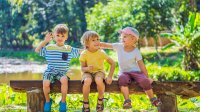Kindergarten Buddy Benches
A kindergarten buddy bench is a sweet way to encourage friendships and SEL skills among our youngest students.
Your content has been saved!
Go to My Saved Content.When I asked my kindergartner what she looked forward to the most in school, her answer had nothing to do with academics: She said she looked forward to making new friends. As a former kindergarten teacher and now a parent, I know that school can be a scary place for a kindergartner, especially when they do not feel included by their peers. Buddy benches are a simple yet powerful tool to promote friendship, and having a kindergarten buddy bench in the playground is a great way for students to practice kindness and empathy. I was thrilled to hear that my daughter’s school was taking a proactive approach to promoting inclusion by raising money to buy a buddy bench.
What is a buddy bench?
In 2013, a second grader named Christian Bucks came to his teachers with the idea of a buddy bench. He envisioned a specially designated seat in the school’s playground where students could go if they did not have anybody to play with or if they wanted someone to talk to. Today, buddy benches exist around the country, and they serve as a place for students who do not feel included to be seen and heard.
Buddy benches work because they are a physical place that makes other kids aware of how someone is feeling. If a student sees someone sitting on the bench, it’s like a call to action that gives the student the power to help someone in need feel better with a simple act of kindness.
Promoting Kindness and Empathy
Buddy benches are one tool that can help promote kindness and empathy, lessen loneliness, and help combat bullying in schools. How do we know when students are not being included during recess? Buddy benches create awareness, and with awareness comes the responsibility to act.
We can teach students to act with kindness and compassion in the classroom, explaining that a buddy bench is an opportunity for them to connect with others and help someone in need. Explain that they can use the bench to have conversations with their peers and get to know each other better. Provide conversation starters to help them initiate a discussion with their peers. Read books or tell stories that emphasize kindness and empathy, and have discussions about the characters’ feelings and actions. Ask questions such as, “How did the character feel when someone helped them?”
In addition, encourage students to reflect on how their actions may impact others. Take time to discuss the buddy bench during circle time or group discussions, and use positive reinforcement to help students develop kind and empathetic behaviors.
Developing Communication as a Social and Emotional Skill
Fostering a healthy learning environment and building a community of learners will help students flourish both academically and socially. Good communication is a key social skill that helps students connect with others and fosters healthy relationships and interactions. Students need to learn how to communicate how they are feeling, as well as how to listen to others’ feelings.
As a teacher, I provided many opportunities for students to practice good communication skills with their peers. I had students take turns speaking and expressing their thoughts, feelings, and ideas in a respectful manner. We practiced and modeled active listening skills such as facing the speaker, keeping eye contact, and nodding or responding appropriately. We used the R-time program (relationships to improve education) to practice courtesy and cultivate friendships in the classroom. We set expectations for students to use kind words and phrases like “Please,” “I’m sorry,” “Excuse me,” and “You’re welcome.”
Remember to praise students when you observe kind actions and hear kind words. Explain that the buddy bench is a good tool to practice those good communication skills when expressing their feelings and showing kindness by being active listeners.
Model, model, model!
As with everything else that is taught in kindergarten, explicitly teaching and modeling how the buddy bench works is key if we want it to be successful. When introducing the buddy bench, teachers and staff members should role-play different social situations. Provide students with sentence stems such as “Hi, my name is… Would you be my friend?”
During recess, encourage different kids to sit on the bench and others to practice coming and asking them to play. Teachers should also be aware if someone is sitting on the bench and no one is coming to their aid. Have an open and honest conversation with students about each scenario, and continue to model and praise kindness and empathetic behaviors. Students will always rise to the occasion.
The kindergarten buddy bench is an opportunity for students to practice kindness and empathy and build their social foundational skills, as well as to help kids nurture long-lasting friendships. Implementing the concept of a buddy bench starting in kindergarten will set the tone for an inclusive learning environment. Students will begin their educational journey with a positive view of the school community.
The kindergarten bench can be used by any other grade level as long as it is needed. However, as children progress through grade levels at school by continually practicing kindness and empathy and remembering what they learned in kindergarten, hopefully they will begin to recognize the signs of someone in need and continue to take action without requiring a tangible symbol of friendship.
